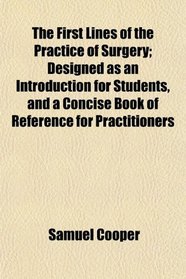Search -
The First Lines of the Practice of Surgery; Designed as an Introduction for Students, and a Concise Book of Reference for Practitioners
The First Lines of the Practice of Surgery Designed as an Introduction for Students and a Concise Book of Reference for Practitioners
Author:
General Books publication date: 2009 Original publication date: 1813 Original Publisher: Longman Notes: This is a black and white OCR reprint of the original. It has no illustrations and there may be typos or missing text. When you buy the General Books edition of this book you get free trial access to Million-Books.com where you can select ... more »
Author:
General Books publication date: 2009 Original publication date: 1813 Original Publisher: Longman Notes: This is a black and white OCR reprint of the original. It has no illustrations and there may be typos or missing text. When you buy the General Books edition of this book you get free trial access to Million-Books.com where you can select ... more »
ISBN-13: 9781150513299
ISBN-10: 1150513292
Publication Date: 12/20/2009
Pages: 510
Rating: ?
ISBN-10: 1150513292
Publication Date: 12/20/2009
Pages: 510
Rating: ?
0 stars, based on 0 rating




